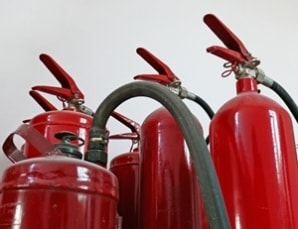A Tough Decision – Deciding on the Right Fire Extinguisher for the Job

A guest blog by John Garland. Use a weighted decision matrix template to help with your fire safety decisions.
All fire extinguishers aren’t alike and there are different fire extinguishers for different types of fire. For example, a person should never use a fire extinguisher filled with water on a grease fire.
Most fire extinguishers can be found in hardware stores or home centers. There are four basic types of fire extinguisher and some of them can put out more than one fire.
Types of Extinguishers
The “A” class fire extinguisher is used for run of the mill combustibles like wood or paper. The “B” class extinguishers are used to put out fires from liquids like grease, propane and paint, while the “C” class extinguishers are made to put out electrical fires. “D” class extinguishers are there to put out fires from metals like magnesium, sodium, potassium and aluminum. Some extinguishers have the logo AB or ABC on their label. Because of this versatility, these are the best sorts of fire extinguishers to use in a home.
Fire extinguishers are most commonly filled with these substances:
Dry Chemicals
Dry chemicals can include sodium bicarbonate, ammonium phosphate, potassium bicarbonate and potassium chloride. This is usually a multiple use extinguisher.
Foams
Foams literally smother a fire and are used for “A” and “B” class fires.
Carbon Dioxide
Carbon dioxide is usually found in “B” and “C” class extinguishers. It doesn’t leave any residue to clean up.
Halocarbons
Halocarbons also leave no residue to clean up and are usually used in industrial fires. Halocarbons actually stop the fire at the chemical level by disrupting the processes that lead to the fire.
Water
Water is ideal for putting out “A” class fires. People might wonder why a modern home needs a water filled fire extinguisher. It’s because it’s more convenient to grab an extinguisher and put out the fire than waiting to fill up a pot or other vessel from a tap. The water in an extinguisher is also under pressure.
After the extinguishers are used, they’ll need to be recharged. The homeowner’s local fire department can do this. The homeowner will know that the extinguisher needs recharging because the arrow on the canister is in the red zone. If the arrow is in the green zone, there’s enough pressure in the extinguisher. The homeowner should check the extinguisher at least once a month to make sure it’s still pressurized and shake it to keep the chemicals from solidifying.
A fire extinguisher should be kept in a readily accessible place in the home, but should be kept away from heat. Heat can degrade its contents.
A homeowner should never try to fight a large fire by him or herself. In case of a large fire, the house should be evacuated and members of the household should be reminded to shut the doors behind them. The household should, in fact, have an evacuation plan. This includes a place where they all meet after they’re safely out of the house.
The fire department should not only be called for large fires but for small ones that seem to have been put out by a fire extinguisher. Some fires can reignite.
For more articles about the types of fire extinguishers available, visit EssentialFireSafety.co.uk.